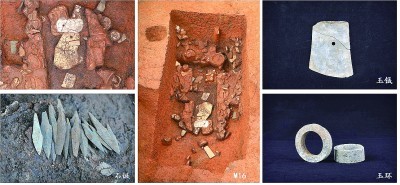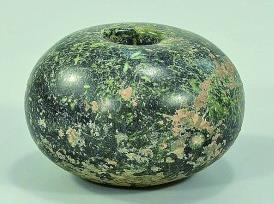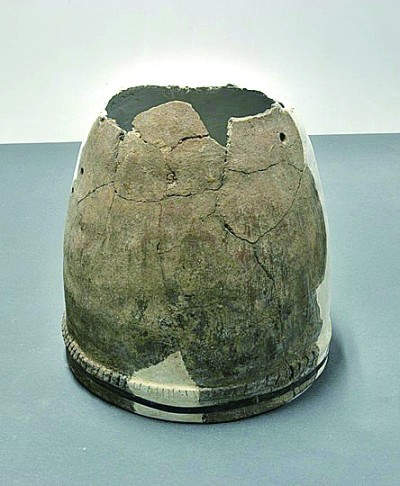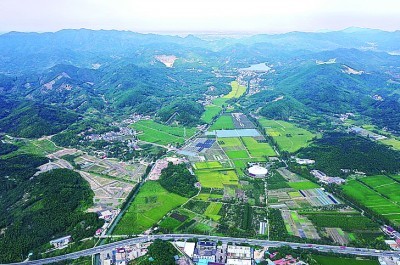The State Administration of Cultural Heritage releases 5 archaeological achievements
Presenting the cultural development process of the Neolithic period in different stages of the Yangtze River, Pearl River and Yellow River Basins
On the 1st, the State Administration of Cultural Heritage held an important progress meeting on the “Archaeological China” major project online. This work will focus on the latest discoveries and research results of the Neolithic Age. Five archaeological projects have shown the development process of Neolithic culture at different stages in the Yangtze River Basin, the Pearl River Basin and the Yellow River Basin.
Through the introduction, it can be seen that in the Neolithic Age between 8,000 and 4,000 years ago, although the cultures of various regions have their own characteristics, clues of cultural exchange and integration have appeared; and archaeology is using multidisciplinary cooperation. This archaeological result demonstrates the structure of the pluralistic integration of Chinese civilization. As Song Xinchao, deputy director of the State Administration of Cultural Heritage said: “In the beginning, China has formed a rudimentary shape during this period.” (Reporter Li Yun)
Geographical Location Information Picture of Shi’ao Site
Ancient rice fields at the Shi’ao site in Yuyao, Zhejiang: the three largest rice fields in the world
■Project introduction: The ancient rice field at Shi’ao Site is located in Yuyao City, Zhejiang Province. It is currently the largest, oldest, and most evidenced large-scale rice field in the world.
The preliminary exploration site has a total area of about 900,000 square meters. The large-scale rice field remains of the Hemudu Culture and Liangzhu Culture were excavated this time, dating back from about 6,700 to 4,500 years. According to Wang Yonglei, a librarian from the Zhejiang Provincial Institute of Cultural Relics and Archaeology, they discovered in the ancient rice fields of the Liangzhu Culture a road network composed of raised ridges forming a “well”-shaped structure, and an irrigation system composed of river channels, canals, and irrigation outlets. Four plots with areas of 750, 700, 1900, and 1300 square meters were confirmed.
■Expert comments:
Shi’ao ancient rice fields can be said to be a world-class discovery. There are not many ancient farmlands found in the world, but rice fields have been found in Jiangsu and Zhejiang in our country, especially during the Liangzhu period. However, like Shi Ao, it includes the rice fields of the early Hemudu, the late Hemudu, and Liangzhu periods, and there are so many plots, in addition to the canals, water outlets, small roads, ridges, the rice fields themselves, and the inclusions in the rice fields. Waiting for a complete system, such a discovery is still rare. It is of great significance for us to understand the development of rice agriculture in the entire southeast region, especially the lower reaches of the Yangtze River. It cannot be overemphasized. With irrefutable evidence, Shi Ao showed the development trend of rice agriculture in the lower reaches of the Yangtze River.
——Chen Xingcan (Director of the Institute of Archaeology, Chinese Academy of Social Sciences)

Profile picture of high-grade tombs in Yingdeyan Shanzhai, Guangdong
Yingdeyan Mountain Village Site in Guangdong: The largest Neolithic settlement in Lingnan
■Project introduction: The Yanshanzhai site is located in Yingde City, Guangdong Province. It is the largest Neolithic settlement site in the Lingnan area so far, filling the blank of settlement archeology at the origin stage of civilization in the Lingnan area.
Liu Suoqiang, a researcher at the Guangdong Provincial Institute of Cultural Relics and Archaeology, said that the total area of the site is about 50,000 square meters, including multiple functional areas such as residential areas and burial areas. However, the residential areas are also mixed with a small number of tombs, which shows that residential life and funerals are not completely separated. A total of 66 tombs were excavated in the burial area. The tombs show obvious hierarchical differentiation. High-level tombs generally carry jade objects. Among them, there are more than 140 burial objects in the 16th tomb, including the Gaojie jade cong, which is the largest in the Lingnan area. He believes that the Shixia culture to which the site belongs is four to five thousand years old, and has played a pivotal role in the interaction and cultural exchanges between the Yangtze River Basin and the Lingnan area at the origin of civilization.
■Expert comments:
The jade found at the Yanshanzhai site has obvious characteristics of Liangzhu culture, indicating that Liangzhu culture has radiated here. This discovery is very important. The cultural exchanges at that time, especially the spiritual exchanges, were realized through jade.
——Wang Renxiang (Researcher, Institute of Archaeology, Chinese Academy of Social Sciences)
Regarding the development of the Lingnan area, it was thought that Emperor Qin Shihuang did not start until the six countries unified. In fact, there are more and more archaeological evidences confirming that the development of this area has started as early as the prehistoric period or even earlier, and not only from the direction of Hunan The cultural diffusion of the south, and the influence of the Liangzhu culture from the southeast. The discovery of Yanshanzhai can once again provide evidence that the development process of civilization in this area is of great significance to the formation of Chinese civilization.
——Li Shuicheng (Professor of School of Archaeology, Arts and Sciences, Peking University)

Data pictures of artifacts unearthed at Nanzuo site in Gansu
Nanzuo Site in Qingyang, Gansu: A giant prehistoric site that has never been seen before
■Project introduction: The Nanzuo Site is located in Xifeng District, Qingyang City, Gansu Province. It is a large-scale settlement site of the Yangshao culture.
According to Han Jianye, a professor at the School of History of Renmin University of China, archaeological investigations preliminarily determined that the Nanzuo site covers an area of about 6 million square meters, dating back from 5200 to 4600 years. The core area of the site is about 300,000 square meters, enclosed by 9 large rammed earth platforms, and 2 ring trenches are found immediately outside the rammed earth platforms. In the core area, there is a palace-style building F1 with an indoor area of about 630 square meters. The walls and ground are all multi-layered white and gray surfaces. White piled pottery, white cloth pottery, white pottery, black pottery, and cinnabar painted pottery have been unearthed in F2. There are large faience pots, flat-bottom faience pots with caps and bells, and a large number of rice remains, showing a high level of social development.
■Expert comments:
This is a giant site “unseen before”. First, the overall scale is unprecedented, with a total area of 6 million square meters, which is 2 million square meters larger than the Shimao site, which is twice the size of the Erlitou site known so far; the second is the unprecedented size of the core area. , Its core area is about 300,000 square meters, the same size as Mojiao Mountain at Liangzhu Site, and there are 9 rammed earth platforms around it, and there are 2 ring trenches outside of the rammed earth platforms; the third is the large size of the house. Not seen, only the indoor part of F1 is 630 square meters, and the volume scale is unmatched in the same period. This large-scale late Yangshao settlement is one of the largest settlement sites around 5,000 years ago. It embodies strong social public power and indicates that Longdong may have entered an early state or civilized society.
——Zhang Chi (Professor of School of Archaeology, Arts and Sciences, Peking University)

A profile picture of the head of a jade scepter unearthed at the Geyaochuan site
Geyachuan Site in Zhangjiachuan, Gansu: Another Central Area of Yangshao Culture
■Project Introduction: Geyachuan Site is located in Zhangjiachuan Hui Autonomous County, Gansu Province. It lasted from the early stage of Yangshao culture to the late stage of Yangshao culture, dating back from 6100 to 5600.
According to Chen Guoke, a researcher at the Gansu Provincial Institute of Cultural Relics and Archaeology, the Geyachuan site is another important archaeological discovery after the Dadiwan site on the Longxi Loess Plateau. Among them, the large ring settlements of the early historian type of the Yangshao Culture are well preserved, covering an area of about 80,000 square meters. Three ring trenches are found on the periphery of the settlement. The central area is a square with three groups of houses distributed in a centripetal shape around the square. More than 100 seats. A large number of pottery, stone, jade, and bone objects were unearthed at the site. The pottery was mainly colored pottery, and a jade scepter head was also found.
■Expert comments:
The discovery of the Geyachuan site gave us a deeper understanding of the treasure region of the Loess Plateau, and a more accurate and deeper understanding of the status of the Yangshao culture. The age of this site is in the transitional stage from the early Yangshao culture to the most prosperous Miaodigou period. The painted pottery, house layout and structure in the site all show such a transitional style. This shows that the most important turning point of the Yangshao culture began in the hinterland of the Loess Plateau with Longdong as the center. The most prosperous Miaodigou era in Yangshao was conceived here, and the ancestors of the Yangshao culture were real sons and daughters of the loess. This important discovery, like the discovery of the Nanzuo site, helps to change the traditional understanding that the Yangshao culture belongs to the culture of the Central Plains, and helps to interpret the grand process of the formation of Chinese civilization from a new perspective of pluralism.
——Li Xinwei (Researcher of the Institute of Archaeology, Chinese Academy of Social Sciences)

Profile picture of cylindrical tank unearthed in Dengcaogouliang, Zhangjiakou, Hebei
Dengcaogouliang Site in Zhangjiakou, Hebei: Consolidating Zhangjiakou’s “Three Forks” Position
■Project introduction: The Dengcaogouliang site is located in Chongli District, Zhangjiakou City, Hebei Province.
According to Wang Gang, a researcher at the Hebei Provincial Institute of Cultural Relics and Archaeology, four stages of cultural relics have been discovered at the Dengcaogouliang site, dating back about 8000, 6500, 5100, and 4200-4000. The remains are close to the surrounding Xinglongwa Culture, Hougang Culture, Yangshao Culture, and Longshan Culture of the same period. Zhangjiakou is located in the transition zone between the nomadic culture of northern my country and the farming culture of the Central Plains. It is an important channel for cultural exchanges between the Bohai Rim in the east and the inland culture in the west. The discovery of cultural relics with different appearances in four stages from 8,000 to 4,000 years ago proves that the region has been an important area of multi-ethnic and multi-cultural integration since ancient times.
■Expert comments:
This discovery can be said to have the significance of filling in the gaps.
We must realize the importance of Zhangjiakou area, which is the important meaning of the cultural exchanges between the North and the South, and the cultural exchanges between the East and the West, that is, the meaning of “Sanchakou”. Zhangjiakou area is an important cultural area, and it is likely to represent a new archeological cultural area, especially in the period from 8000 to 7000 years ago, it may have its own important cultural characteristics. Around 6000 years ago, the eastern and western cultures had a major collision in the area north along the Great Wall, and Zhangjiakou was in this area. This collision had an important influence on the later culture of this area.
——Li Shuicheng (Professor of School of Archaeology, Arts and Sciences, Peking University)
.
